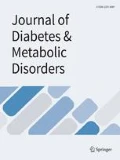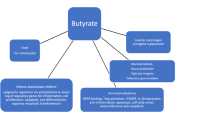Abstract
Background and aims
сomparative animal study of effectiveness of intermittent administration of lyophilized single-, three- and alive multistrain probiotic in short courses on insulin resistance (IR) in rats with experimental obesity.
Methods
70 rats were divided into 7 groups (n = 10 in each). Rats of group I were left intact. Newborn rats in groups II-VII were administered monosodium glutamate (MSG) (4 mg/g) by injection. Rats in group II (MSG-obesity group) were left untreated. The rats in groups III-V received lyophilized mono-probiotics B.animalis VKL, B.animalis VKB, L.casei IMVB-7280 respectively. The rats in group VI received all three of these probiotic strains mixed together. Group VII was treated with multi-probiotic “Symbiter”, containing 14 different live probiotic strains (Lactobacillus, Bifidobacterium, Propionibacterium, Acetobacter genera).
Results
Treatment of newborn rats with MSG lead to the development of obesity in all MSG-obesity rats and up to 20–70% after probiotic administration. Additions to probiotic composition, with preference to alive strains (group VII), led to significantly lower rates of obesity, decrease in HOMA-IR (p < 0.001), proinflammatory cytokines levels – IL-1β (p = 0.003), IL-12Bp40 (p < 0.001) and elevation of adiponectin (p = 0.003), TGF-β (p = 0.010) in comparison with MSG-obesity group. Analysis of results in groups treated with single-strain probiotics (groups III-V) shows significant decrease in HOMA-IR, but changes were less pronounced as compared to mixture groups and did not achieve intact rats level. Other metabolic parameters were not affected significantly by single strains.
Conclusion
Our findings provide major clues for how to design and use probiotics with more efficient compositions in obesity and IR management and may bring new insights into how host-microbe interactions contribute to such protective effects.



Similar content being viewed by others
References
World Health Organization. Obesity and overweight. Fact sheet N 311, http://www.who.int/mediacentre/factsheets/fs311/en, 2015.
Dee A, Kearns K, O’Neill C, Sharp L, Staines A, O’Dwyer V, et al. The direct and indirect costs of both overweight and obesity: a systematic review. BMC Res Notes. 2014;7:242. https://doi.org/10.1186/1756-0500-7-242.
Melvin A, O'Rahilly S, Savage DB. Genetic syndromes of severe insulin resistance. Curr Opin Genet Dev. 2018;50:60–7. https://doi.org/10.1016/j.gde.2018.02.002.
Mykhalchyshyn G, Kobyliak N, Bodnar P. Diagnostic accuracy of acyl-ghrelin and it association with non-alcoholic fatty liver disease in type 2 diabetic patients. J Diabetes Metab Disord. 2015;14:44. https://doi.org/10.1186/s40200-015-0170-1.
Kyriachenko Y, Falalyeyeva T, Korotkyi O, Molochek N, Kobyliak N. Crosstalk between gut microbiota and antidiabetic drug action. World J Diabetes. 2019;10:154–68. https://doi.org/10.4239/wjd.v10.i3.154.
Cani PD, Amar J, Iglesias MA, Poggi M, Knauf C, Bastelica D, et al. Metabolic endotoxemia initiates obesity and insulin resistance. Diabetes. 2007;56:1761–72. https://doi.org/10.2337/db06-1491.
Kobyliak N, Falalyeyeva T, Boyko N, Tsyryuk O, Beregova T, Ostapchenko L. Probiotics and nutraceuticals as a new frontier in obesity prevention and management. Diabetes Res Clin Pract. 2018;141:190–9. https://doi.org/10.1016/j.diabres.2018.05.005.
Kim MH, Kang SG, Park JH, Yanagisawa M, Kim CH. Short-chain fatty acids activate GPR41 and GPR43 on intestinal epithelial cells to promote inflammatory responses in mice. Gastroenterol. 2013;145:396–406. https://doi.org/10.1053/j.gastro.2013.04.056.
Puddu A, Sanguineti R, Montecucco F, Viviani GL. Evidence for the gut microbiota short-chain fatty acids as key pathophysiological molecules improving diabetes. Mediat Inflamm. 2014;2014:162021. https://doi.org/10.1155/2014/162021.
Shi H, Kokoeva MV, Inouye K, Tzameli I, Yin H, Flier JS. TLR4 links innate immunity and fatty acid-induced insulin resistance. J Clin Invest. 2006;116:3015–25. https://doi.org/10.1172/JCI28898.
Renga B, Mencarelli A, Vavassori P, Brancaleone V, Fiorucci S. The bile acid sensor FXR regulates insulin transcription and secretion. Biochim Biophys Acta. 1802;2010:363–72. https://doi.org/10.1016/j.bbadis.2010.01.002.
Ding L, Yang L, Wang Z, Huang W. Bile acid nuclear receptor FXR and digestive system diseases. Acta Pharm Sin B. 2015;5:135–44. https://doi.org/10.1016/j.apsb.2015.01.004.
Hill C, Guarner F, Reid G, Gibson GR, Merenstein DJ, Pot B, et al. Expert consensus document: the international scientific Association for Probiotics and Prebiotics consensus statement on the scope and appropriate use of the term probiotic. Nat Rev Gastroenterol Hepatol. 2017;14:491–502. https://doi.org/10.1038/nrgastro.2017.75.
Kobyliak N, Abenavoli L, Falalyeyeva T, Mykhalchyshyn G, Boccuto L, Kononenko L, et al. Beneficial effects of probiotic combination with omega-3 fatty acids in NAFLD: a randomized clinical study. Minerva Med. 2018;109:418–28. https://doi.org/10.23736/S0026-4806.18.05845-7.
Kobyliak N, Abenavoli L, Mykhalchyshyn G, Falalyeyeva T, Tsyryuk O, Kononenko L, et al. Probiotics and smectite absorbent gel formulation reduce liver stiffness, transaminases and cytokine levels in NAFLD associated with type 2 diabetes: a randomized clinical study. Clinical Diabetology. 2019;8:205–14. https://doi.org/10.5603/DK.2019.0016.
Kobyliak N, Falalyeyeva T, Mykhalchyshyn G, Kyriienko D, Komissarenko I. Effect of alive probiotic on insulin resistance in type 2 diabetes patients: randomized clinical trial. Diabetes Metab Syndr. 2018;12:617–24. https://doi.org/10.1016/j.dsx.2018.04.015.
Cani PD, Van Hul M. Novel opportunities for next-generation probiotics targeting metabolic syndrome. Curr Opin Biotechnol. 2015;32:21–7. https://doi.org/10.1016/j.copbio.2014.10.006.
Wu TR, Lin CS, Chang CJ, Lin TL, Martel J, Ko YF, et al. Gut commensal Parabacteroides goldsteinii plays a predominant role in the anti-obesity effects of polysaccharides isolated from Hirsutella sinensis. Gut. 2019;68:248–62. https://doi.org/10.1136/gutjnl-2017-315458.
Cani PD, de Vos WM. Next-generation beneficial microbes: the case of Akkermansia muciniphila. Front Microbiol. 2017;8:1765. https://doi.org/10.3389/fmicb.2017.01765.
Kobyliak N, Falalyeyeva T, Beregova T, Spivak M. Probiotics for experimental obesity prevention: focus on strain dependence and viability of composition. Endokrynol Pol. 2017;68:659–67. https://doi.org/10.5603/EP.a2017.0055.
Olney JW. Brain lesions, obesity, and other disturbances in mice treated with monosodium glutamate. Science. 1969;164:719–21. https://doi.org/10.1126/science.164.3880.719.
Kobyliak N, Falalyeyeva T, Bodnar P, Tl B. Probiotics supplemented with Omega-3 fatty acids are more effective for hepatic Steatosis reduction in an animal model of obesity. Probiotics Antimicrob Proteins. 2017;9:123–30. https://doi.org/10.1007/s12602-016-9230-1.
Kondro M, Mykhalchyshyn G, Bodnar P, Kobyliak N, Falalyeyeva T. Metabolic profile and morpho-functional state of the liver in rats with glutamate-induced obesity. Curr. Issues Pharm. Med Sci. 2013;26:379–81. https://doi.org/10.12923/j.2084-980X/26.4/a.05.
Kobyliak N, Abenavoli L, Falalyeyeva T, Virchenko O, Natalia B, Beregova T, et al. Prevention of NAFLD development in rats with obesity via the improvement of pro/antioxidant state by cerium dioxide nanoparticles. Clujul Med. 2016;89:229–35. https://doi.org/10.15386/cjmed-632.
Kobyliak N, Abenavoli L, Falalyeyeva T, Beregova T. Efficacy of probiotics and Smectite in rats with non-alcoholic fatty liver disease. Ann Hepatol. 2018;17:153–61. https://doi.org/10.5604/01.3001.0010.7547.
Novelli ELB, Diniz YS, Galhardi CM, Ebaid GM, Rodrigues HG, Mani F, et al. Anthropometrical parameters and markers of obesity in rats. Lab Anim. 2007;41:111–9.
Vogeser M, Konig D, Frey I, Predel HG, Parhofer KG, Berg A. Fasting serum insulin and the homeostasis model of insulin resistance (HOMA-IR) in the monitoring of lifestyle interventions in obese persons. Clin Biochem. 2007;40:964–8.
Broberger C, Johansen J, Johansson C, Schalling M, Hokfelt T. The neuropeptide Y/agouti generated protein (AGRP) brain circuitry in normal, anorectic, and monosodium glutamate-treated mice. Proc Natl Acad Sci U S A. 1998;95:15043–8.
Dawson R, Pelleymounter MA, Millard WJ, Liu S, Eppler B. Attenuation of leptin-mediated effects by monosodium glutamate-induced arcuate nucleus damage. Am J Phys. 1997;273:202–6.
Matysková R, Maletínská L, Maixnerová J, Pirník Z, Kiss A, Zelezná B. Comparison of the obesity phenotypes related to monosodium glutamate effect on arcuate nucleus and/or the high fat diet feeding in C57BL/6 and NMRI mice. Physiol Res. 2008;57:727–34.
Li X, Wang E, Yin B, Fang D, Chen P, Wang G, Zhao J et al. Effects of lactobacillus casei ccfm419 on insulin resistance and gut microbiota in type 2 diabetic mice. Benef. Microbes 2017; 8: 421–432. doi: https://doi.org/10.3920/BM2016.0167. doi: 10.5603/EP.a2017.0055.
Yadav H, Jain S, Sinha PR. Antidiabetic effect of probiotic dahi containing Lactobacillus acidophilus and Lactobacillus casei in high fructose fed rats. Nutrition. 2007;23:62–8. https://doi.org/10.1016/j.nut.2006.09.002.
Park DY, Ahn YT, Park SH, Huh CS, Yoo SRYR, et al. Supplementation of Lactobacillus curvatus HY7601 and Lactobacillus plantarum KY1032 in diet-induced obese mice is associated with gut microbial changes and reduction in obesity. PLoS One. 2013;8:e59470. https://doi.org/10.1371/journal.pone.0059470.
Carreras NL, Martorell P, Chenoll E, Genovés S, Ramón D, Aleixandre A. Anti-obesity properties of the strain Bifidobacterium animalis subsp. lactis CECT 8145 in Zücker fatty rats. Benef Microbes. 2018;9:629–41. https://doi.org/10.3920/BM2017.0141.
Roselli M, Finamore A, Brasili E, Rami R, Nobili F, Orsi C, et al. Beneficial effects of a selected probiotic mixture administered to high fat-fed mice before and after the development of obesity. J Funct Foods. 2018;45:321–9.
Alard J, Lehrter V, Rhimi M, Mangin I, Peucelle V, Abraham AL, et al. Beneficial metabolic effects of selected probiotics on diet-induced obesity and insulin resistance in mice are associated with improvement of dysbiotic gut microbiota. Environ Microbiol. 2016;18:1484–97. https://doi.org/10.1111/1462-2920.13181.
Holowacz S, Guigné C, Chêne G, Mouysset S, Guilbot A, Seyrig C, et al. A multispecies Lactobacillus- and Bifidobacterium-containing probiotic mixture attenuates body weight gain and insulin resistance after a short-term challenge with a high-fat diet. Pharma Nutrition. 2015;3:101–7.
Karimi G, Jamaluddin R, Mohtarrudin N, Ahmad Z, Khazaai H, Parvaneh M. Single-species versus dual-species probiotic supplementation as an emerging therapeutic strategy for obesity. Nutr Metab Cardiovasc Dis. 2017;27:910–8. https://doi.org/10.1016/j.numecd.2017.06.020.
Hsieh FC, Lan CC, Huang TY, Chen KW, Chai CY, Chen WT, et al. Heat-killed and live Lactobacillus reuteri GMNL-263 exhibit similar effects on improving metabolic functions in high-fat diet-induced obese rats. Food Funct. 2016;7:2374–88. https://doi.org/10.1039/c5fo01396h.
Kikuchi K, Ben Othman M, Sakamoto K. Sterilized bifidobacteria suppressed fat accumulation and blood glucose level. Biochem Biophys Res Commun. 2018;501:1041–7. https://doi.org/10.1016/j.bbrc.2018.05.105.
Acknowledgments
The authors express their sincere thanks to Dr. Yankovsky Dmitro Stanislavovych for the help, advice and financial support of this work.
Author information
Authors and Affiliations
Corresponding author
Ethics declarations
Conflict of interest
None to declare.
Additional information
Publisher’s note
Springer Nature remains neutral with regard to jurisdictional claims in published maps and institutional affiliations.
Rights and permissions
About this article
Cite this article
Kobyliak, N., Falalyeyeva, T., Tsyryuk, O. et al. New insights on strain-specific impacts of probiotics on insulin resistance: evidence from animal study. J Diabetes Metab Disord 19, 289–296 (2020). https://doi.org/10.1007/s40200-020-00506-3
Received:
Accepted:
Published:
Issue Date:
DOI: https://doi.org/10.1007/s40200-020-00506-3




